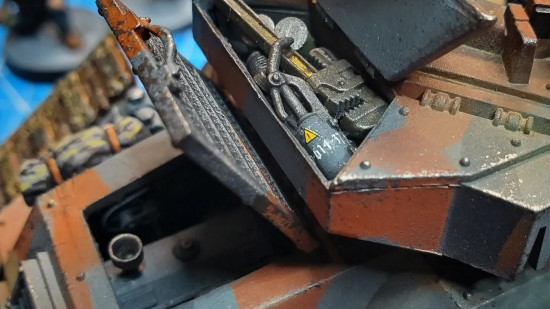Rotate this Leman Russ model through 180 degrees and you’ll reveal a cutaway interior with enough detail that it looks like it belongs in a tank museum. Though this diorama makes the Leman Russ look like a believable piece of military hardware, its creator – Warhammer 40,000 fan and former U.S. Army tank crew Adam Huenecke – explains why the Russ would be a sitting duck if it ever rolled out onto a real world battlefield.
“I served as a crewman for the U.S. Army on an M1A2 Abrams tank for four years”, Huenecke says, as “a driver for a few years, then a gunner”. He’s also studied tanks “at places like the Fort Knox armor museum” and other collections, and has a masters degree “focused on the historical memory of the Second World War”, a topic that includes the war’s influence on media like Warhammer 40k.
If your main knowledge of tanks comes from Warhammer 40k books or the tabletop game, you’ve probably picked up some misconceptions about them. “Even the best-designed tanks are unforgiving machines that require constant maintenance and guzzle resources”, Huenecke says.
“I’ve seen 70 ton war machines immobilized by a strand of razor wire which required a torch to remove from the tangled tracks, water cannons, or a single misplaced track endcap that fell into a turret ring”, he adds. “Track is surprisingly fragile, and heavy, and requires lots of maintenance and repair”.
Of all the Warhammer 40k factions, the Astra Militarum have some of the very worst tanks, and they don’t have the Space Marine chapters’ excuse of using imaginary ceramic alloys that could compensate for some of the problems. Huenecke reels off a few issues with the Russ.
The tank has “zero suspension”, as it’s “based on WW1 tanks with track that ran around the entire hull”, and “narrow tracks that don’t extend past the hull”. These tracks would get stuck “on literally anything, like a big stick on the pavement”.
Most of the Russ’ hull “appears to be riveted, which is not typically very strong or survivable”. Rivets are much easier to break than a solid armor plate, creating a line of weakness wherever the plates join. Modern tank bodies are cast in as few pieces as possible, and welded together.
Huenecke says “tank tactics are surprisingly similar to infantry tactics, just faster and at a much longer range”. So “cover and concealment is still paramount for movement and survival”. And though they’re loud, “you can still sneak up on someone with one surprisingly easy”. The Russ’ incredibly tall profile does not help with this at all.
The Russ also has “many flat surfaces that would not deflect rounds, especially on the large, vulnerable flanks”. Then there’s the way the hull gun housing and the front of the tracks project forwards, creating ‘shot traps’ that shells would deflect into on either side of the hull gun, and where explosive energy will be focused in a smaller area when hit.
There have been truly awful tank designs in real world military history. WW2 Germany’s military development processes were afflicted by in-fighting between military branches and Hitler’s Freudian obsession with big tanks. This led to tanks that were over-engineered and prone to breakdowns, like the King Tiger and Elefant.
Huenecke says that the Russ “is clearly based on historical vehicles, there are elements taken directly from real designs, especially very early 20th century tanks”, particularly the British Mk 1 from WW1. He adds that “any vehicle chassis with an adaptable weapon system would be really useful and easy to manufacture”.
Huenecke’s diorama tank, Sumpkroc, is an attempt to make a Russ that looks like ”a crew could plausibly fight inside of it”. You can find more photos of the build process in Huenecke’s Instagram.
He drew on his “own experience and memories with the fighting compartment of the Abrams”. He also emulated features from other tanks, like the “hull of the British Mk 1” which the Russ was based on; “the turret of the Soviet T34/76 which was similarly small” and which required “the commander to also serve as a loader due to limited space”; and “the ammo storage of vehicles like the American / British Sherman tank series”, which had “a similarly versatile but fragile chassis”.
As much as possible, Huenecke tried “to keep the exterior features of the Leman Russ intact”, and create a sense of realism by working on the interior. He “had to create the battlecannon breech and keep enough space in the interior to accommodate for its vertical movement”.
He built the interior “completely from scratch”, other than the hull floor detailing which comes in the kit. “That meant scratch-building a turret ring, ammo storage, and the interior elements for all of the various hull weapons”.
He “used a lot of plastic strips and other bits chopped up to the point they are barely recognizable” to complete the job. Surprisingly, the toughest part of the build was cutting away the hull panels neatly enough that they could be replaced without leaving a visible seam. He gave the edges a red highlight, of the kind you would see in a military tank museum.
Having finished Sumpkroc, Huenecke admits “I learned that I’m not very good at precision scratchbuilding, and don’t care to be better” – he’s happy to cover his errors or messiness with greebles, rather than pursue perfectly straight lines and well placed pipes and rivets. “Fortunately, that is a perfectly cromulent strategy for sci-fi vehicles without any canon depictions of the interior elements”, he adds.
For a very, very different conversion by Huenecke, make sure you check out his Golden Girls Sisters of Battle!
Source: Wargamer




